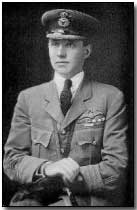Who's Who - William Barker
 William George "Will" Barker
(1894-1930) remains Canada's most highly decorated soldier, serving as a
highly successful fighter pilot during World War One.
William George "Will" Barker
(1894-1930) remains Canada's most highly decorated soldier, serving as a
highly successful fighter pilot during World War One.
Barker, who was born on 3 November 1894 in Dauphin, Manitoba, enlisted with the Canadian Mounted Rifles in December 1914, determined to play a role in the Great War. For a little over a year Barker served in the trenches of the Western Front before requesting (and receiving) a transfer to the Royal Flying Corps in April 1916, initially as a mechanic.
Operating from August 1916 as an observer Barker nevertheless claimed his first 'kill' of the war - he was to finally amass some 50 victories - from the rear seat of a B.E.2d.
Receiving training in England for the right to fly in his own right Barker was able to fly solo after just 55 minutes of air tuition and was awarded his pilot's certificate in January 1917. Within a month he was back on the Western Front in command of an R.E.8, remaining until injury from anti-aircraft fire forced his return to England on 7 August 1917.
Following a period of recuperation Barker acted briefly as a flight instructor before returning to France and, from November 1917, to the Italian Front. While there Barker's Sopwith Camel (#B6313) gained the distinction of becoming the single most successful fighter aircraft of the war until its eventual retirement in early October 1918 with Barker having collected 46 victories in the aircraft. His remarkable record is often overlooked simply because much of his success was achieved away from the publicity glare of the Western Front.
Returning to England in October 1918 he was given command of the flight training school at Hounslow. However before taking up his new responsibilities he determined to spend a short period flying over the Western Front.
Already the recipient of a DSO with bar and the Military Cross with bar, on 27 October 1918 began an action that resulted in his being awarded the Victoria Cross. In a dogfight - and while flying alone - his Sopwith Snipe came under attack by no fewer than fifteen German Fokker D.VII's. Despite twice fainting from his injuries he downed four and drove off the remainder. During the encounter he suffered three wounds and ended the bout by crash landing behind Allied lines.
In 1920, following a short-lived commercial aviation venture with fellow-ace Billy Bishop, Barker joined the Royal Canadian Air Force and was despatched to London as liaison officer to the Air Ministry. While there he worked on a project to assign flying routes through the Middle East, and flew for several months between Iraq and Palestine.
Resigning from the Royal Canadian Air Force in August 1926 Barker returned to Canada and worked in the tobacco industry in Norfolk County, Ontario until illness forced him to sell his interests in 1929. He also served as the first president of the Toronto Maple Leafs. On 12 March 1930, Barker was killed while (as new President of the Fairchild Aviation Corporation of Canada) he demonstrated a new two-seater aircraft at Rockcliffe Aerodrome, near Ottawa.
It has been suggested that his death, from apparent engine failure, may have in fact been deliberate. It is certainly the case that Barker suffered from debilitating depression in the post-war years, and suffered greatly from his war wounds.
"Devil Dogs" was the nickname given to the U.S. Marines by the German Army.
- Did you know?
